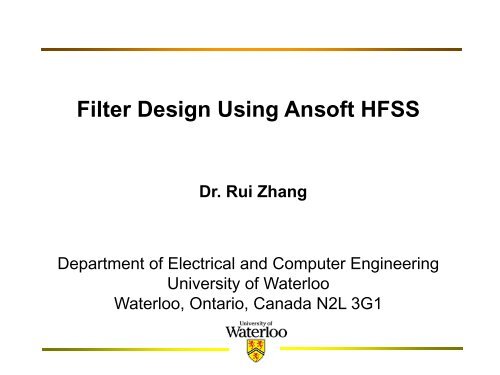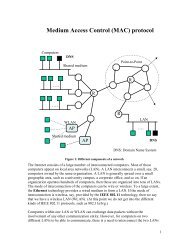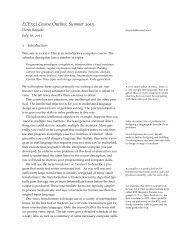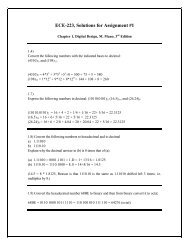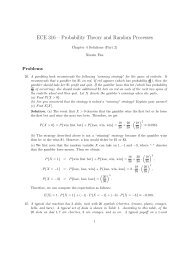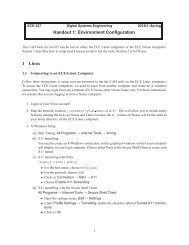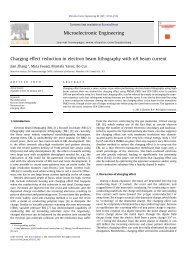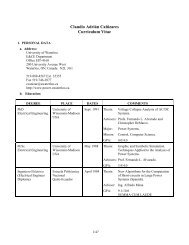Filter Design Using Ansoft HFSS - Electrical and Computer ...
Filter Design Using Ansoft HFSS - Electrical and Computer ...
Filter Design Using Ansoft HFSS - Electrical and Computer ...
You also want an ePaper? Increase the reach of your titles
YUMPU automatically turns print PDFs into web optimized ePapers that Google loves.
<strong>Filter</strong> <strong>Design</strong> <strong>Using</strong> <strong>Ansoft</strong> <strong>HFSS</strong><br />
Dr. Rui Zhang<br />
Department of <strong>Electrical</strong> <strong>and</strong> <strong>Computer</strong> Engineering<br />
University of Waterloo<br />
Waterloo, Ontario, Canada N2L 3G1
Introduction<br />
Outline<br />
Finite Element Method (FEM) Employed by <strong>HFSS</strong><br />
Features of <strong>HFSS</strong><br />
General <strong>Design</strong> Procedure<br />
<strong>Design</strong> Examples:<br />
Eigen Mode: Dielectric Resonator<br />
Driven Mode: Dielectric Resonator <strong>Filter</strong><br />
Microstrip Line Structure<br />
1
Introduction<br />
The <strong>Ansoft</strong> High Frequency Structure Simulator (<strong>HFSS</strong>)<br />
is a full-wave electromagnetic (EM) software package for<br />
calculating the electromagnetic behavior of a 3-D structure.<br />
<strong>Using</strong> <strong>HFSS</strong>, you can compute:<br />
Basic electromagnetic field quantities <strong>and</strong>, for open<br />
boundary problems, radiated near <strong>and</strong> far fields;<br />
The eigenmodes, or resonances, of a structure;<br />
Port characteristic impedances <strong>and</strong> propagation constants;<br />
Generalized S-parameters <strong>and</strong> S-parameters renormalized<br />
to specific port impedance;<br />
2
FEM<br />
FEM is a numerical method for solving Maxwell Equations.<br />
Meshing Scheme:<br />
2D-triangles<br />
3D-tetrahedra<br />
3
Capabilities:<br />
Features of <strong>HFSS</strong><br />
Accurate full-wave EM simulation<br />
Import/export of 3D structures<br />
Automatic adaptive mesh generation <strong>and</strong> refinement<br />
Adaptive Lanczos-Padé Sweep for fast frequency sweeps<br />
Inclusion of skin effect, losses<br />
Direct <strong>and</strong> iterative matrix solvers<br />
Eigen mode matrix solver<br />
4
Solution Data (Visualization):<br />
Features of <strong>HFSS</strong> (cont.)<br />
S-, Y-, Z-parameter matrix (2D plot, Smith Chart)<br />
Port characteristic impedance<br />
Current, E-field, H-field (3D static <strong>and</strong> animated field<br />
plot in vector display or magnitude display)<br />
Far-field calculation (2D, 3D, gain, radiation pattern)<br />
Material losses, radiation losses<br />
5
General <strong>Design</strong> Procedure<br />
6
<strong>Design</strong> Examples (Eigen mode: DR)<br />
Opening a <strong>HFSS</strong> Project<br />
To open a new project in a <strong>HFSS</strong> window:<br />
Select File > New, select Project > Insert <strong>HFSS</strong> <strong>Design</strong><br />
To open an existing project:<br />
7
<strong>Design</strong> Examples (Eigen mode: DR) cont.<br />
Project Manager<br />
8
<strong>Design</strong> Examples (Eigen mode: DR) cont.<br />
Solution Type<br />
Driven Modal: S-matrix solutions will be expressed in terms<br />
of the incident <strong>and</strong> reflected powers of waveguide modes.<br />
Driven Terminal: S-matrix solutions of multi-conductor<br />
transmission line ports will be expressed in terms of terminal<br />
voltages <strong>and</strong> currents.<br />
Eigen Mode: finding the resonant frequencies of the<br />
structure <strong>and</strong> the fields at those resonant frequencies.<br />
To Set the Solution Type<br />
Select <strong>HFSS</strong> > Solution Type<br />
9
3D Modeler<br />
<strong>Design</strong> Examples (Eigen mode: DR) cont.<br />
10
<strong>Design</strong> Examples (Eigen mode: DR) cont.<br />
Parametric Model Creation<br />
YZ<br />
XZ<br />
11
<strong>Design</strong> Examples (Eigen mode: DR) cont.<br />
Defining Variables<br />
12
<strong>Design</strong> Examples (Eigen mode: DR) cont.<br />
Variable Settings<br />
Add new variables<br />
13
<strong>Design</strong> Examples (Eigen mode: DR) cont.<br />
Checking <strong>and</strong> Modifying Dimensions in 3D Modeler Tree<br />
3D Modeler Tree<br />
14
<strong>Design</strong> Examples (Eigen mode: DR) cont.<br />
Assigning Materials<br />
15
<strong>Design</strong> Examples (Eigen mode: DR) cont.<br />
Properties of the Objects<br />
16
<strong>Design</strong> Examples (Eigen mode: DR) cont.<br />
Common Boundary Conditions<br />
Material properties<br />
- Boundary between two dielectrics<br />
- Finite conductivity of a conductor<br />
Surface approximations<br />
- Perfect electric or magnetic surfaces<br />
- Radiation surfaces<br />
- Symmetry planes<br />
- Background or outer surfaces<br />
Excitations (Driven mode)<br />
- Wave ports (External)<br />
- Lumped ports (Internal)<br />
17
<strong>Design</strong> Examples (Eigen mode: DR) cont.<br />
Assigning Boundaries<br />
18
<strong>Design</strong> Examples (Eigen mode: DR) cont.<br />
Analysis Setup<br />
19
<strong>Design</strong> Examples (Eigen mode: DR) cont.<br />
Adaptive Meshing<br />
The mesh in <strong>HFSS</strong> is automatically constructed <strong>and</strong> tuned<br />
to give the most accurate <strong>and</strong> efficient mesh possible.<br />
The adaptive meshing algorithm searches for the largest<br />
gradients in the E-field or error <strong>and</strong> sub-divides the mesh in<br />
those regions. It also targets singularities, such as the edge<br />
of a conductor, as locations to add extra elements.<br />
The mesh growth for each adaptive pass is controlled by<br />
the Tetrahedron Refinement in percentage, which ensures<br />
that between each pass the mesh is sufficiently perturbed<br />
<strong>and</strong> guarantees the correct convergences.<br />
After the mesh has been refined, a full solution is performed<br />
<strong>and</strong> the process is repeated until convergence.<br />
20
<strong>Design</strong> Examples (Eigen mode: DR) cont.<br />
Convergence<br />
After each adaptive pass, <strong>HFSS</strong> compares the results<br />
(Frequencies for eigen mode, S-Parameters for driven<br />
mode) from the current mesh to the results of the previous<br />
mesh. If the answers have not changed by the user defined<br />
value or Delta Freq (for eigen mode)/Delta S (for driven<br />
mode), then the solution has converged <strong>and</strong> the current or<br />
previous mesh can be used to perform a frequency sweep<br />
(for driven mode).<br />
If the solution has converged, then technically, the previous<br />
mesh is as good as the current mesh. In this case, <strong>HFSS</strong><br />
will use the previous mesh (less than current mesh) to<br />
perform frequency sweeps (for driven mode) if they have<br />
been requested.<br />
21
<strong>Design</strong> Examples (Eigen mode: DR) cont.<br />
Validation Check <strong>and</strong><br />
Starting Analysis<br />
22
<strong>Design</strong> Examples (Eigen mode: DR) cont.<br />
Monitoring the Solution Process<br />
<strong>and</strong> Checking Solution Data<br />
Q will be provided for lossy cases<br />
23
Plotting Mesh<br />
<strong>Design</strong> Examples (Eigen mode: DR) cont.<br />
24
<strong>Design</strong> Examples (Eigen mode: DR) cont.<br />
Field Distributions<br />
25
<strong>Design</strong> Examples (Driven mode: DR <strong>Filter</strong>)<br />
3D Model of the DR <strong>Filter</strong><br />
26
<strong>Design</strong> Examples (Driven mode: DR <strong>Filter</strong>) cont.<br />
Excitation<br />
Probe Port<br />
The height of the cylinder is 0<br />
= a sheet in a circular shape<br />
27
<strong>Design</strong> Examples (Driven mode: DR <strong>Filter</strong>) cont.<br />
Defining Port<br />
28
<strong>Design</strong> Examples (Driven mode: DR <strong>Filter</strong>) cont.<br />
Wave Port<br />
<strong>HFSS</strong> assumes that the Wave Port is connected to<br />
a semi-infinite long waveguide that has the same<br />
cross-section <strong>and</strong> material properties as the port.<br />
Wave ports calculate characteristic impedance,<br />
complex propagation constant, <strong>and</strong> generalized<br />
S-Parameters.<br />
Lumped Port<br />
Lumped ports are similar to traditional wave ports,<br />
but can be located internally <strong>and</strong> have a complex<br />
user-defined impedance.<br />
29
<strong>Design</strong> Examples (Driven mode: DR <strong>Filter</strong>) cont.<br />
Analysis Setup<br />
Single Frequency<br />
30
<strong>Design</strong> Examples (Driven mode: DR <strong>Filter</strong>) cont.<br />
Analysis Setup (cont.)<br />
Frequency Sweep<br />
31
<strong>Design</strong> Examples (Driven mode: DR <strong>Filter</strong>) cont.<br />
Solution Data<br />
32
<strong>Design</strong> Examples (Driven mode: DR <strong>Filter</strong>) cont.<br />
Plotting Solution Data<br />
33
<strong>Design</strong> Examples (Driven mode: DR <strong>Filter</strong>) cont.<br />
Port Field Display<br />
34
<strong>Design</strong> Examples (Driven mode: DR <strong>Filter</strong>) cont.<br />
Parametric Analysis<br />
35
<strong>Design</strong> Examples (Driven mode: DR <strong>Filter</strong>) cont.<br />
Optimization<br />
36
<strong>Design</strong> Examples (Driven mode: DR <strong>Filter</strong>) cont.<br />
Optimization (cont.)<br />
37
<strong>Design</strong> Examples (Driven mode: MSL)<br />
3D Model of the MSL<br />
38
<strong>Design</strong> Examples (Driven mode: MSL)<br />
Port Field Display<br />
39
Solution Data<br />
<strong>Design</strong> Examples (Driven mode: MSL)<br />
40


